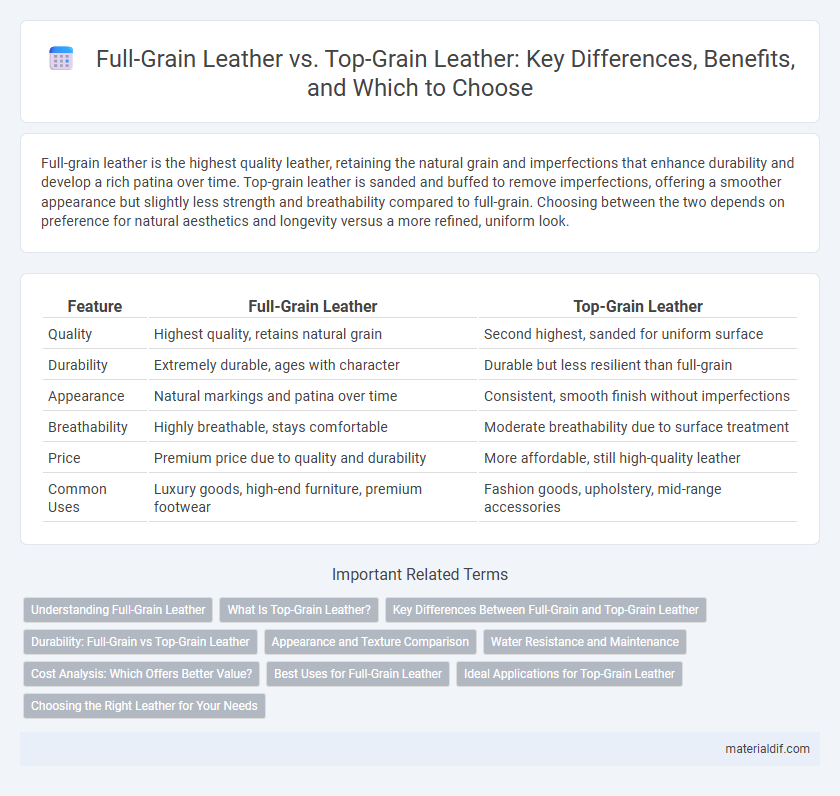Full-grain leather is the highest quality leather, retaining the natural grain and imperfections that enhance durability and develop a rich patina over time. Top-grain leather is sanded and buffed to remove imperfections, offering a smoother appearance but slightly less strength and breathability compared to full-grain. Choosing between the two depends on preference for natural aesthetics and longevity versus a more refined, uniform look.
Table of Comparison
| Feature | Full-Grain Leather | Top-Grain Leather |
|---|---|---|
| Quality | Highest quality, retains natural grain | Second highest, sanded for uniform surface |
| Durability | Extremely durable, ages with character | Durable but less resilient than full-grain |
| Appearance | Natural markings and patina over time | Consistent, smooth finish without imperfections |
| Breathability | Highly breathable, stays comfortable | Moderate breathability due to surface treatment |
| Price | Premium price due to quality and durability | More affordable, still high-quality leather |
| Common Uses | Luxury goods, high-end furniture, premium footwear | Fashion goods, upholstery, mid-range accessories |
Understanding Full-Grain Leather
Full-grain leather is the highest quality leather, made from the top layer of the hide that includes all natural grain, offering superior durability and breathability. It ages beautifully, developing a unique patina over time, reflecting its natural texture and markings. Unlike top-grain leather, full-grain retains the hide's original surface, making it stronger and more resistant to wear.
What Is Top-Grain Leather?
Top-grain leather is the second-highest quality of leather, made by sanding and refinishing the hide's surface to remove imperfections. This process results in a more uniform and smooth texture compared to full-grain leather, which retains the natural grain. Top-grain leather is widely used in premium furniture, handbags, and automotive upholstery due to its balance of durability and refined appearance.
Key Differences Between Full-Grain and Top-Grain Leather
Full-grain leather retains the natural surface and imperfections of the hide, providing superior durability, breathability, and a unique patina over time, making it the highest quality leather available. Top-grain leather is sanded and buffed to remove flaws, resulting in a smoother, more uniform appearance but slightly reduced durability and breathability compared to full-grain. The key differences lie in the finishing process, texture, longevity, and how each develops character with use, impacting their suitability for high-end furniture, footwear, and accessories.
Durability: Full-Grain vs Top-Grain Leather
Full-grain leather offers superior durability due to its retention of the entire grain layer, making it more resistant to wear and tear compared to top-grain leather, which undergoes sanding to remove imperfections. This sanding process weakens top-grain leather's surface, reducing its strength and lifespan in high-stress applications. Full-grain leather not only develops a unique patina over time but also maintains structural integrity far longer than the more processed top-grain variety.
Appearance and Texture Comparison
Full-grain leather showcases a natural, unaltered surface with visible grain patterns and minor imperfections that enhance its unique character, offering a rich, textured feel. Top-grain leather undergoes sanding and buffing to remove imperfections, resulting in a smoother, more uniform appearance with a consistent texture. The durability of full-grain leather complements its rugged aesthetic, while top-grain's refined finish suits polished, sleek designs.
Water Resistance and Maintenance
Full-grain leather offers superior water resistance due to its intact natural grain, allowing it to develop a resilient patina over time that enhances durability. Top-grain leather undergoes sanding and refinishing, which reduces its water resistance and makes it more susceptible to staining and moisture damage. Maintenance for full-grain leather involves regular conditioning to preserve its protective qualities, while top-grain leather requires frequent cleaning and sealing to prevent water absorption.
Cost Analysis: Which Offers Better Value?
Full-grain leather, known for its durability and natural texture, typically commands a higher price due to its superior quality and longer lifespan, making it a worthwhile investment for long-term use. Top-grain leather is more affordable and features a smoother, more uniform finish resulting from sanding and refinishing, but it tends to wear out faster and may require earlier replacement. Evaluating the cost per year of use reveals full-grain leather offers better value for consumers prioritizing durability and longevity over initial savings.
Best Uses for Full-Grain Leather
Full-grain leather is ideal for applications requiring maximum durability and natural aesthetics, such as high-end furniture, luxury handbags, and premium footwear. Its unaltered surface retains the hide's original grain, providing superior strength, breathability, and aging characteristics. This makes full-grain leather the preferred choice for products designed to withstand heavy use while developing a unique patina over time.
Ideal Applications for Top-Grain Leather
Top-grain leather, known for its smooth surface and durability, is ideal for high-use items such as upholstery, handbags, and footwear where a refined appearance with moderate resistance to wear is essential. Its sanded and treated finish offers enhanced stain resistance and easier maintenance compared to full-grain leather, making it suitable for everyday products requiring a balance of aesthetics and functionality. This type of leather provides a consistent texture, perfect for fashion accessories and furniture that demand both style and practical longevity.
Choosing the Right Leather for Your Needs
Full-grain leather offers exceptional durability and natural aging qualities, making it ideal for long-lasting, high-quality products, while top-grain leather provides a smoother surface with refined aesthetics and easier maintenance. Choosing the right leather depends on the intended use: full-grain suits rugged goods like boots and wallets, whereas top-grain is preferable for stylish, everyday items such as handbags and furniture. Understanding the balance between toughness and appearance helps determine the best leather type for your specific needs.
Full-Grain Leather vs Top-Grain Leather Infographic

 materialdif.com
materialdif.com